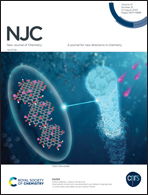A unique covalently linked pyridine-tetrathiafulvalene as a stimuli-sensitive sensor for the specific, selective optical and electrochemical detection of Pb2+†
Abstract
An efficient and new synthetic strategy was highlighted to target a covalently linked pyridine-tetrathiafulvalene (Py-TTF) dyad. As evidenced by colorimetric tests, UV-vis analyses and cyclic voltammetry measurements, the Py-TTF dyad shows a specific and a selective recognition of Pb2+ ions over other metal cations. A drastic and unique variation of color, specific changes of the intramolecular charge transfer band of the Py-TTF dyad, and an unchanged oxidation potential Eox2 compared to Eox1 were observed in the presence of Pb2+ ions. The direct linkage between Py and TTF units through a covalent carbon–carbon bond ensures optimal electronic communication between both units, thus allowing an optical and electrochemical response to Pb2+ in organic solution with high selectivity and specificity compared to other metal cation species MX+ (MX+ = Fe2+, Mg2+, Pb2+, Na+, Zn2+, Ag+, Cd2+, and Cs+).



 Please wait while we load your content...
Please wait while we load your content...